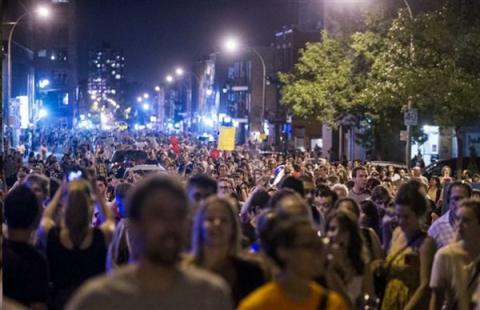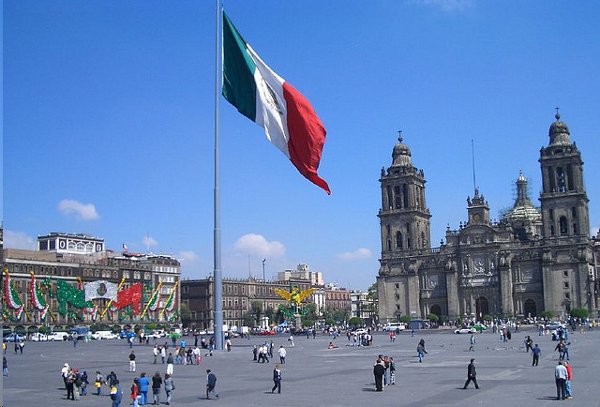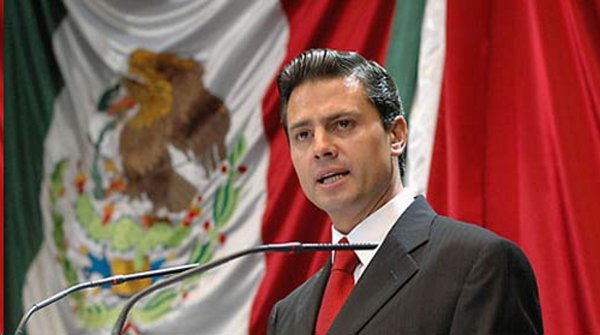A Quiet Revolution Brews in Mexico

From New America Media and Frontera NorteSur:
As immigrants rally in cities across the United States today, another drumbeat of protest and revolt beats loudly in southern Mexico. Beginning as a teachers’ strike against a new federal education law last February, the protest is now transforming into a broad popular movement against not only the much-touted Pact for Mexico policies of new President Enrique Pena Nieto, but also the political and economic structures they are based on.
In the bigger scheme of things, the movement is squarely challenging an economic and educational agenda endorsed by the International Monetary Fund, Organization for Economic Cooperation and Development and Wall Street.
If the movement could be said to have an epicenter, it is in the Pacific state of Guerrero, where the protest against the federal education reform took a big leap this month with the founding of the Guerrero Popular Movement (MPG). Opponents of the law passed last December by the Mexican Congress argue that a new evaluation system imposed on teachers jeopardizes labor rights and contains other provisions that will foster privatization and increase the cost of sending children to school.
Formed by unions, small farmer organizations, indigenous communities and youth activists, the MPG declared its opposition to the education reform, new mining projects in indigenous communities, any privatization of the national oil company Pemex, and proposals to increase the 16 percent sales tax.
“Now this is not just a movement of the teachers,” proclaimed the Regional Coordinator of Community Authorities, the leadership body of the community police and justice system in scores of Guerrero’s indigenous communities. “It’s a struggle of all small farmers, parents, students, political and social organizations”
Government officials routinely minimize support for the teacher strike, but the MPG flexed its muscles with two large demonstrations that paralyzed the Guerrero state capital of Chilpancingo earlier this month. According to different estimates, each action drew between 50,000 and 120,000 people.

As its first order of business, the MPG supported an unsuccessful attempt by striking teachers to modify the federal education reform law by passing union-drafted legislation at the state level.
Represented by the Guerrero State Coordinator of Education Workers (CETEG), a large dissident organization within the official SNTE teachers’ union, the strikers combined street protests and occupations of government buildings with intense legislative lobbying efforts and on-and-off again negotiations with Guerrero Governor Angel Aguirre.
At one point sensing victory within its grasp, the CETEG suddenly suffered a major setback when state lawmakers from President Pena Nieto’s PRI party, backed by allies from other political parties including members of the once-emblematic PRD opposition party, approved a state law last week that ignored the CETEG’s main proposals and upheld the federal reform. The pro-reform lawmakers asserted that any legislation differing significantly from the federal law would not pass constitutional muster. They deny the reform will bring educational privatization.
As many as 9,000 CETEG and MPG supporters surged through the streets April 24 chanting slogans and denouncing the legislators. After a rally, protest leaders urged demonstrators to return to the strikers’ encampment in the capital city.
Whether due to manipulation by publicly unknown elements or spontaneous and uncontrollable rage, a large crowd that turned rowdy ignored the post-rally plans and began heading for the headquarters of the major political parties-left, right and center.
The crowd then trashed the party buildings- without political distinction- but dished out special treatment to the PRI, whose headquarters was thoroughly ransacked and torched. Columns of black smoke poured from the building before the blaze was extinguished.
“When the people rise up for bread, freedom and land, the powerful will tremble, from the Gulf to the Sierra!” the rioters chanted.
While some journalists were reportedly rousted, no one was injured in the violence, expect for one protestor who suffered a hand injury.

The April 24 Chilpancingo incident put the CETEG and MPG on the defensive, as the Mexican commercial media, which has treated the strike with hostility since the get-go, flashed images of the vandalism and the PRI fire. A litany of denunciations flowed from the political and business classes.
While in Acapulco for a bankers’ convention, President Pena Nieto curtly condemned the Chilpancingo violence. Faulting unidentified “external forces” for stoking a violent and intolerant movement, PRD Guerrero Governor Angel Aguirre announced that 39 arrest warrants were ready for strike leaders. Graco Ramirez, governor of neighboring Morelos state, called strike leaders “true delinquents” who should be detained.
Mumblings from shadowy government and media sources variously blamed the mayhem, with no concrete proof, on the EPR and ERPI guerrilla groups and even on left opposition leader and two-time presidential candidate Andres Manuel Lopez Obrador
Acapulco Mayor Luis Walton reiterated an appeal to the CETEG to refrain from blockading the Mexico City-Acapulco freeway, a tactic which led to recent confrontations with the Federal Police. Walton urged the strikers to conduct themselves in a manner that would not affect tourism in Acapulco, which accounts for 40 percent of the economic activity in impoverished Guerrero.
“Of course, the Federation should intervene,” Walton added. “It’s a federal law that motivated this problem. There has to be dialogue. If not, this will not be solved…”
Conversely, more than a few messages praising the trashings and arson attack on the PRI circulated on the Internet, with writers reflecting the seething anger a large sector of Mexican society holds for the government and all the political parties represented in it.
CETEG spokespersons eventually acknowledged that some of its supporters were to blame for a rampage not sanctioned by the leadership
If the conflict over the education reform law wasn’t enough to literally inflame a political crisis, a Guerrero state court added fuel to the fire the same week as the Chipancingo upheaval when it freed two state policemen accused of killing two students from the Ayotzinapa rural teachers’ college, Gabriel Echeverria de Jesus and Jorge Alexis Herrera, during a demonstration in December 2011.

Ayotzinapa is legendary for its student militancy, and the school is the alma matter for the locally revered guerrilla leaders Genaro Vazquez Rojas and Lucio Cabanas Barrientos of the 1960s and 1970s.
Indeed, a favorite chant of thousands of demonstrators in recent weeks has been, “Cuidado, cuidado, cuidado con Guerrero, estado guerrillero.” Simply put, the chant warns the government not to mess with a guerrilla state.
Last week, Ayotzinapa’s current generation of pupils lived up to the college’s reputation when students- reinforced by thousands of supporters from the CETEG and MPG- briefly blockaded the Mexico City-Acapulco freeway in Chilpancingo in a protest against a judge’s decision to free the alleged killers of their classmates.
Rocks were tossed at a contingent of federal officers monitoring the march, who responded with obscene finger gestures, but no major escalation of violence ensued.
For teachers, their movement has entered a critical phase. Trial balloons of replacing the strikers are floating in the air, and students stand to lose an entire semester if the conflict drags on much longer. Regrouping during the past few days, the CETEG and MPG are organizing May Day marches in Chilpancingo, Acapulco and other towns.
While Guerrero simmers, allied popular movements in the states of Chiapas, Oaxaca, Morelos and Michoacan are turning up the heat in their localities. All four states have very active local affiliates of the National Coordinator of Education Workers (CNTE), the CETEG’s national organization, and are witnessing the formation of broad popular fronts like Guerrero’s MPG. The CNTE plans an escalation of protests after May 1, when a large national march with other unions will also be convened in Mexico City.
So far, the movement has not gathered force in any big way in the central and northern border states, but teachers in the Resssiste organization of Ciudad Juarez are reportedly planning to stage a protest on May 1, a Mexican holiday.
Oaxaca education workers’ leader Ruben Nunez said the groundwork is being laid for a national strike against labor, education and energy reforms.

“In the (CNTE), we are preparing the terrain, the conditions, for an ongoing national mobilization,” Nunez said. “In Oaxaca, we already have the possibility, at any given moment, of setting the date for the uprising.”
Perhaps what distinguishes the current movement from previous ones is that teachers and their allies are proposing very detailed, alternative public policies or actually implementing them on the ground, as in the case of Guerrero’s community police and justice system.
Following the lead of Guerrero, CNTE affiliates in Chiapas and Michoacan have now struck many schools.
“We are clear that the ongoing strike reduces the number of school days,” said Michoacan CNTE official Victor Manuel Zavala. “But to not struggle against this badly-intentioned reform is to renounce the existence of public schools.”
In what might be interpreted as an attempt to curb the further spread of the movement, the general secretary of the official SNTE in the Pacific state of Colima has announced that two sections of the organization will not participate in the government-sponsored May Day parade. However, SNTE oficialistas in Chiapas have announced they will participate in a May 1 protest alongside the CNTE.
Union official Jose de Jesus Villanueva said the virtually unprecedented decision was necessary to counter “goon squads” from Guerrero and Michoacan trying to agitate the local teachers. However, it’s more likely the decision was made to curtail any possible, embarrassing protests by rank-and-file teachers against the education reform law.
Like Guerrero, the situation in Michoacan is reported as explosive, with student protests adding to a charged atmosphere.
Since last fall, students from the Tiripetio rural teachers’ college have repeatedly clashed with authorities over demands for resources and a guaranteed quota of 1,000 jobs for graduates. Last week, the “Tiris,” as they have become known, commandeered trucks belonging to Coca-Cola, Bimbo and other food and beverage firms. In Robin Hood style, the students gave away goods from companies that have a profitable business in schools to eager passerby in the state capital of Morelia.
In a message handed to the trucks’ drivers, the students claimed they took the action because of a government cutoff of resources to their schools. In preparation for a large May Day protest in Morelia, the Working Peoples Unitary Front declared that the public was “fed up” with low wages, jobs with no benefits, constant price increases, shoddy public transportation, and attacks on free public education.
Complicating the political landscape is Michoacan’s seemingly entrenched narco-violence, a phenomenon separate from, yet economically and sociologically linked to, the poverty and generalized discontent that underpins current social conflicts.
Simultaneous crises related to narco-violence, insecurity and social demands are tugging at the state, worsened by last weekend’s shootout that claimed 14 lives and resulted in numerous school closures in the Tierra Caliente region of the state. Finding himself immersed in a socio-political whirlwind, PRI Governor Fausto Vallejo, who was elected in a controversial 2011 election riddled with allegations of fraud, announced earlier this month he was taking a 90-day leave of absence, presumably to attend health problems.
And in an almost surreal cameo appearance in the unfolding Michoacan drama, Servando “La Tuta” Gomez Martinez, the presumed fugitive leader of the Knights Templar syndicate that controls a good chunk of Michoacan and surrounding states, popped up April 27 on a YouTube video.
Looking like Farmer Jones with a cow in the background for a prop, Gomez criticized Vallejo’s performance as governor and called for dialogue to restore order in Michoacan. The media-savvy Gomez counseled the state and federal governments to negotiate with his organization as well as the teachers and students. “We are delinquents,” he said, “but we are disposed to seek convincing measures to establish order, not only in Michoacan, but wherever we can.”
Octavio Ferris Leal, who served as an intelligence official under the PRD administration of former Michoacan Governor Lazaro Cardenas Batel (2000-2006), contended that a “hydra” of multiple conflicts, many of them connected to organized crime, has reared its deadly head over the land.
“It’s dangerous, since it could provoke a social explosion, not only in an entity governed by an inept and incompetent PRI, but in the entire country,” Ferris warned. “(Michoacan) could be the spark.”
In Guerrero too, the political fuse is very short, illustrated by the April 29 deliverance of Governor Angel Aguirre’s second government report while under the guard of thousands of police and transported supporters. Despite the recent developments in his state, an upbeat Aguirre insisted that “social peace and governance” prevail.
Earlier commenting on the political turbulence, the Guerrero edition of La Jornada newspaper contended that the conflict sprouting from the education reform law is a complex, multifaceted one that encompasses issues of poverty, rebellious cultural peculiarities, political arrogance, poverty, and the federal abandonment of schools. The daily’s editors appealed for dialogue over repression.
“One could say that Guerrero is a powder keg,” the newspaper editorialized. “All that is missing is a match.”
In a separate piece, La Jornada columnist Raul Suarez Martinez also called for calm in a state that has “lost control.”
As a remedy to the polarization, Martinez proposed the creation of a peace commission for Guerrero similar to the initiative launched in Chiapas after the 1994 Zapatista uprising.
“The causes are different, which is to say they haven’t arrived to the extremes of Chiapas,” Suarez continued. “ It’s clear that only an external commission, removed from the conflict but which understands its roots and possible solutions, can defuse it.”
Picture above: Servando “La Tuta” Gomez Martinez, the presumed leader of the Knights Templar Cartel that controls much of Michoacan, appeared in an April 27 YouTube video.
Photos: New America Media, R. Barbosa, Schlaeger (Creative Commons).






























































































































































































































































































































